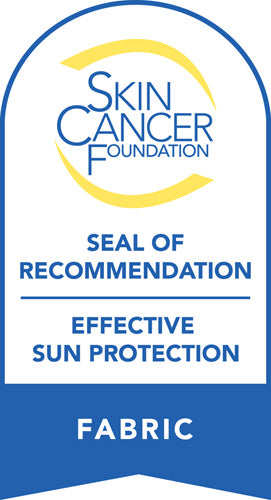The Importance of Sun Protection for Sensitive Skin in Fall and Winter
According to a Harvard Health Publishing article, many people believe they have a "sun allergy," but it isn't an allergy. It's a reaction from the immune system that occurs when sunlight hits the skin, leading to an itchy red rash. This condition is known as Polymorphous Light Eruption (PMLE) and often appears on the neck, hands, arms, and lower legs.
To protect sensitive skin from destructive UV rays, especially in the fall and winter, it's important to learn about sun protection for sensitive skin. You can keep the skin safe and healthy by knowing how to care for it during these cooler months. Read on for more helpful tips and insights, and visit BloqUV for expert advice on keeping your skin protected.
Understanding Sensitive Skin in Fall and Winter
Sensitive skin is prone to irritation, redness, dryness, and itching. It reacts easily to environmental changes, certain fall and winter skincare products, and fabrics. This sensitivity can make it more challenging to maintain a healthy balance.
The drop in temperature, lower humidity, and exposure to cold winds can strip sensitive skin of its natural oils. It often leads to increased dryness, flakiness, and irritation. While you may turn to indoor heating as a solution, it can further dehydrate the skin, making it more vulnerable to discomfort.
Protecting sensitive skin from damaging sun rays is vital, even in fall and winter. Some may think sun protection is only necessary during the summer months. However, UV rays can still affect the skin year-round.
Why Sun Protection for Sensitive Skin in Fall and Winter Matters
Protecting your sensitive skin from the sun is crucial in fall and winter. Even though it's cooler outside, UV rays can still harm your skin. In the following sections, you will learn about the reasons for sun protection to keep your skin safe and healthy in fall and winter.
Year-Round UV Exposure
UV rays are present all year long, not just in the summer. Many people think they only need sun protection during warm months. However, UV rays can reach our skin every season, especially in fall and winter, when people often overlook their sun protection needs.
In winter, the sun may not feel as strong, but it still emits UV rays that can harm our skin. The cold air can also dry out the skin, making it more vulnerable to irritation. This combination of dry conditions and UV exposure can lead to discomfort, particularly for sensitive skin.
As the days become shorter and temperatures drop in fall, many people think they are safe from the sun. However, UV rays can still be strong on sunny fall days. The sun's angle during this season can also lead to more direct UV exposure, making sun protection important even when the air is cool.
For individuals with sensitive skin, the challenges of fall and winter can be particularly tough. Their skin can react more easily to UV rays, resulting in redness and irritation. Awareness of the unique risks associated with these seasons is essential for overall skin health, reminding everyone that UV protection is important for sun safety year-round.
Clouds Don't Block UV Rays
Cloudy conditions in fall and winter result from changes in weather patterns. During these seasons, cool air can trap warm, moist air, leading to clouds forming in the sky. As a result, we often see overcast days and less sunlight.
Many people think they are safe from UV rays on cloudy days. However, clouds do not block these rays completely. Most of the harmful UV rays can still reach your skin, even when it's overcast.
It's especially important for people with sensitive skin. Sensitive skin can easily become red or irritated from UV exposure. Even a small amount of UV rays in winter can cause discomfort, making it crucial to recognize the risks.
When it's cloudy, some may feel relaxed and think they don't need sun protection. But the reality is that UV rays are still present. Therefore, those with sensitive skin should remain aware of their surroundings, regardless of the weather.
Understanding that clouds do not fully shield us from UV rays helps raise awareness. The knowledge is vital for sensitive skin care all year round. It serves as a reminder that sun protection is necessary, even on seemingly safe days.
Snow Reflects UV Rays
Snowy conditions can create hidden dangers for our skin. When sunlight hits the snow, UV rays reflect off its surface. This reflection can double the amount of UV radiation that reaches our skin, increasing the risk of sun damage, especially for sensitive skin.
The CDC Yellow Book 2024 notes that several factors affect UV exposure. These include the time of year, the time of day, and the location. For example, most UV rays reach the Earth in the summer when the sun is strongest.
Furthermore, Ultraviolet B (UVB) rays are more intense from 10 AM to 4 PM. They are intense in higher elevations and places near the equator. In these areas, the combination of altitude and proximity to the sun can greatly increase UV exposure.
As such, people must be extra cautious in snowy environments. The reflection of UV rays on snow can lead to more sun damage than expected. Understanding these risks is essential for protecting sensitive skin during winter activities.
Reduced Skin Barrier
The skin acts like a shield to protect our bodies from harmful environmental elements. Different layers work together to remove dirt, germs, and pollution. The outer layer, called the epidermis, is tough and prevents many bad substances from getting in.
Under the epidermis is the dermis, which has blood vessels and nerves that help the skin stay healthy. The skin also makes oils that keep it moist and add another layer of protection. This barrier helps keep us safe by blocking things that could harm us.
Sensitive skin has a weaker barrier than normal skin. This weak barrier makes it more vulnerable to irritation from UV rays. When exposed to the sun's rays, sensitive skin can easily become red, inflamed, or uncomfortable, especially during colder weather.
In colder months, the skin barrier can become even more compromised. Cold air can dry out sensitive skin, making it more reactive to UV exposure. As such, protection from the sun is especially important to maintain skin health.
Prevents Premature Aging
UV rays tend to break down naturally occurring collagen and elastin, making sensitive skin more susceptible to fine lines, wrinkles, and age spots. By using sun protection, you can help maintain a youthful appearance. Here are four ways premature aging takes effect:
Wrinkles and fine lines slowly appear as collagen and elastin break down.
- Loss of elasticity leads to sagging skin
- Dark spots, or age spots, develop from sun damage
- Dullness and uneven texture result from continuous sun exposure
Premature aging can make people feel insecure about their appearance. Many individuals may become self-conscious and avoid social situations because they are unhappy with their appearance. Self-consciousness can result in low self-esteem and even depression for some.
However, there are ways to cope with these feelings. Treatments and professional procedures can help reduce signs of aging. Regular sun protection (clothing) and a healthy lifestyle can also improve skin health.
Protects Against Hyperpigmentation
Sensitive skin can develop dark spots, especially with UV exposure. This condition, known as hyperpigmentation, can worsen during the fall and winter. UV rays damage skin cells and affect proteins that keep skin smooth and firm.
When UV rays penetrate the sensitive skin, they can speed up aging and lead to uneven skin tone. They can cause the skin to become loose, with deeper wrinkles and patches of discoloration over time. According to a study in the Environment International journal, UV rays can significantly impact sensitive skin.
You should recognize the link between UV exposure and hyperpigmentation if you have sensitive skin. Protecting your skin helps prevent dark spots and keeps your complexion even. Even better, staying informed about the effects of UV rays encourages you to develop better sun protection habits.
Minimizes Risk of Sunburn
Sunburn happens when your skin gets too much UV radiation from the sun. The radiation damages skin cells and makes your body respond by sending more blood to the area. As a result, sunburned skin becomes red, swollen, hot, and painful.
Many people believe sunburn can only happen on sunny days, but this is a misconception. UV rays can penetrate clouds, meaning you can still get burned even when overcast. Additionally, some think that people with darker skin are immune to sunburn, but while they may have some natural UPF protection, they can still experience sunburn and skin damage.
UV rays are divided into two main types: UVA and UVB. UVA rays can lead to skin aging, while UVB rays are primarily responsible for sunburn. Both types pose risks to your skin, as they can cause long-term damage and increase the likelihood of developing skin issues, such as age spots and uneven skin tone.
Severe sunburn can be more than just uncomfortable; it can also pose health risks. Blisters and peeling skin can develop from extreme sunburn. In serious cases, sunburn can lead to heat exhaustion or heat stroke, which are dangerous conditions requiring medical attention.
Reduces Risk of Skin Cancer
Sun protection all year is very important to lower the risk of skin cancer. Like tanning beds, getting too much UV exposure can increase this risk over time. According to a National Library of Medicine study, solar UV radiation and UV-emitting tanning devices can lead to skin cancer.
Skin cancer is the undeniably most commonly diagnosed cancer in the U.S. UV rays can damage skin cells and lead to changes that might turn into cancer. So, staying informed about UV exposure helps everyone make better choices for their skin.
Understanding the link between UV exposure and skin cancer can encourage people to develop safer sun habits. Such habits include wearing sun-protective clothing, no matter the season. By doing this, individuals can protect their skin for the long term.
Helps Maintain Moisture Levels
When your skin is well-hydrated, it looks smooth and feels soft. However, it can become itchy, flaky, and irritated when dry. Here are sun protection tips to maintain the right moisture levels in the skin in fall and winter:
- Stay hydrated by drinking enough water to keep your skin moist from the inside out
- Apply a good-quality moisturizer to create a barrier that locks in moisture and prevents dryness
- Use warm water and keep showers short
- Add moisture to the air with a humidifier to help prevent your skin from drying out especially in winter
UV exposure can harm your skin and reduce moisture levels in fall and winter. Sunlight can dry out the skin and cause it to lose essential oils. Luckily, layering with UPF clothing shields your skin from the sun, reducing the risk of dryness and irritation.
Supports Overall Skin Health
Health is vital during fall and winter because these seasons can be tough. Cold weather and shorter days can make people feel sad and tired. Therefore, staying healthy helps you enjoy seasonal activities and avoid common illnesses during these months.
In addition, sun protection is important for staying healthy in these seasons. Many think sun protection is only for summer, but UV rays can still damage the skin in fall and winter. Thus, wearing UPF-protected clothing and using sunscreen helps protect your skin from these rays and keeps it healthy all year.
Moreover, there are many myths about sun protection in cooler months. Some people believe they don't need sun protection when it's cloudy or cold. However, UV rays can still get through clouds and reflect off surfaces like snow.
Explore Sun Protection For Sensitive Skin Today
All in all, the importance of sun protection for sensitive skin cannot be overstated. Even in fall and winter, UV rays can harm your skin. By taking steps to protect your sensitive skin, you can maintain its health and prevent damage.
Visit BloqUV today for stylish and effective sun protection for sensitive skin. Our UPF 50+ clothing guarantees to block 98% of harmful UVA and UVB rays. Enjoy peace of mind knowing our sun protection doesn't wash away, keeping your family safe all year round.



